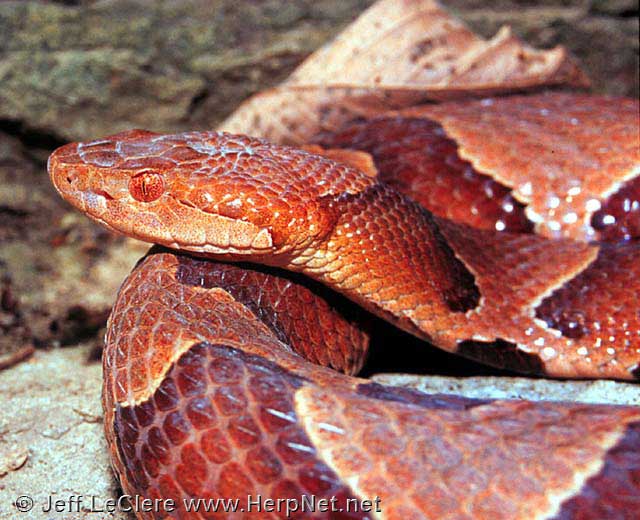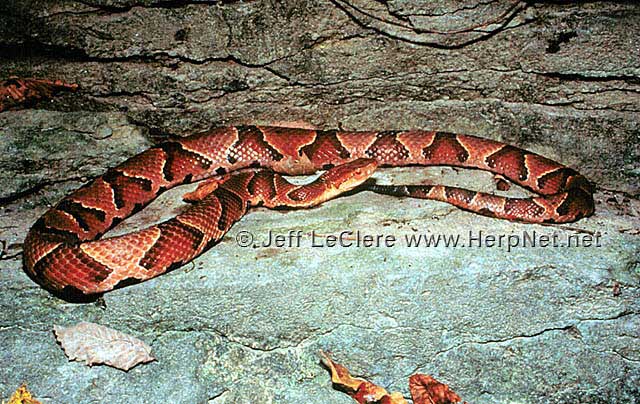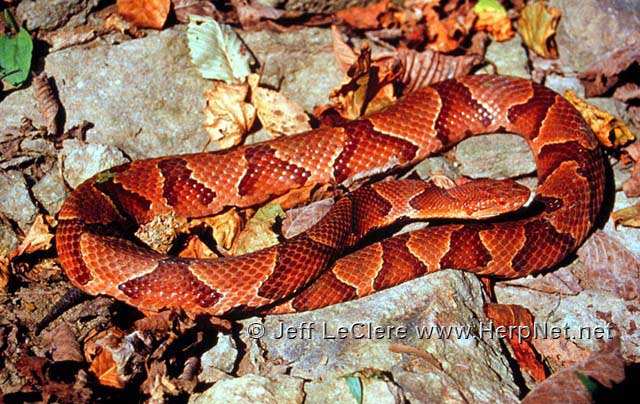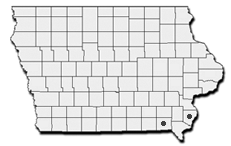Eastern Copperhead (Agkistrodon contortrix)
by Jeff LeClere

Status
ENDANGERED and Species of Greatest Conservation Need. It is illegal to kill or collect this species by law in Iowa. Although eastern copperheads may be quite common in other parts of their range, they are at the northern limits of their range here and are one of Iowa’s rarest snakes. Copperheads are known from only a few small localities in southeastern Iowa. Persons living in extreme southwestern Iowa should keep their eyes open for copperheads. They have been found in western Missouri not far from the Iowa border. We would greatly appreciate any reports of copperheads at all in Iowa.
Description
Dangerously venomous. This is a medium sized Iowa species that is rather heavy bodied and measures from 24 – 36 inches in length; the record is 40 inches (Conant and Collins, 1991). Eastern copperheads have a diamond shaped head which is set off from the relatively thin neck. The pupils of the eyes are elliptical in bright light and there is a heat-sensitive pit between the eye and nostril on both sides of the head.
Ground color is usually some shade of orange in the adults. There are darker cross bands on the body that extend onto the tail. The cross bands are often referred to as hourglass shaped and may be dark orange or rusty brown with darker edges. The overall color of the snake is similar to the copper color of a penny.
The venter is light colored, such as cream, but may be darker or have dark patches of gray or brown in some specimens. The scales are weakly keeled and the anal plate is single. The subcaudals are single (instead of divided as in all harmless Iowa snakes).
Young are patterned the same as the adults and are gray until their first shed. They are 7 – 8 inches in length at birth (Johnson, 1992). Young have a sulfur yellow colored tail tip. This color often changes to greenish gray in adults, but is still distinct.

Subspecies
No subspecies of the eastern copperhead, Agkistrodon contortrix, are currently recognized.
Range
Eastern copperheads are one of the rarest snakes in Iowa and barely enter Iowa in the southeastern corner. They have been recorded in Lee, Van Buren, and Davis counties. The populations are small and they remain only because the integrity of the land on which they occur has been maintained. Some populations are protected by the locals; this has undoubtedly preserved those populations.
There is a record for Atchison County, Missouri (Tom Johnson, personal communication). This could imply the occurrence of eastern copperheads in extreme southwestern Iowa. Anyone living in that part of the state should report any sightings to us. Remember that these snakes are listed as endangered in Iowa, so please do not kill them! A decent photo will be fine and incidental road-killed specimens (from anywhere in Iowa) are welcomed.
Habitat
Eastern copperheads are found in rocky, wooded river or stream valleys in southeastern Iowa. If they are found in southwestern Iowa, they are probably associated with the Missouri River floodplain.

Habits
Eastern copperheads were first reported from Iowa by Bailey in 1942, when R.F. Trump submitted specimens to Bailey. Eastern copperheads had been rumored (but not reported) from Iowa by local people; Trump himself not believing until shown (Downard and Vickers, personal communication). Eastern copperheads are not common anywhere in Iowa to the extent of the abundance that they achieve in southern states.
Eastern copperheads probably emerge from winter dormancy in April or early May and are active until October. The following information on reproduction are was from Fitch (1960). Males may engage in combat. Neither snake strikes or bites during this dance; they elevate the fore parts of their bodies in the air and try to push each other to the ground. The purpose of this activity is poorly understood.
Although mating occurs most often in spring after emergence from winter torpor, they may breed any time during the active season, especially in fall. Females do not produce young every year. Gestation is from 105 – 110 days. They are ovoviviparous; females give birth from 4 – 6 young, although there have been records of higher and lower litter sizes. The young are approximately 223 mm at birth.
In mild spring and fall weather, eastern copperheads are active during the day, but during the hot summer months they are definitely nocturnal. I have found many specimens on the roads at night in Kansas. They may overwinter together and with other snake species in rocky outcroppings. During the summer, they move into the valley bottoms, usually forested land along rivers or creeks, to feed. They migrate back to the den sites in fall.
These snakes do not seem to be aggressive when encountered. There are always exceptions, and some individuals are more snappy when they are really warm, but usually they are quite passive. They are also relatively slow-moving snakes. Fitch (1960) states that eastern copperheads were usually inoffensive unless restrained. He adds that older males were more irritable and gravid females were docile. Many times eastern copperheads use camouflage to avoid detection; they sit motionless and wait for the danger to pass.
Although capable of delivering a dangerous bite, there has never been a death caused by a legitimate eastern copperhead bite in Iowa. To put this in perspective on a larger scale, eastern copperheads are far more common in Missouri and there has never been a death caused by an eastern copperhead bite in that state (Johnson, 1992). The same is true for Illinois (Smith, 1961).
Food
Eastern copperheads feed upon small mammals, frogs, lizards, small snakes, some insects, and birds. The young use caudal luring to attract prey. Frogs and lizards are especially drawn to the wriggling yellow tail. They strike with the aid of the heat pits and release the prey, if it is a mammal. Cold blooded prey and birds are held until the venom takes effect. The eastern copperhead tracks down the mammal by scent and consumes its meal when found.
